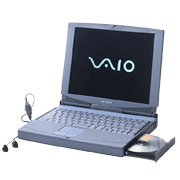The VAIO series of household personal computers was developed with the aim of fusing the latest computer technology with Sony's wealth of audio and video technology. Sony announced the VAIO series in Japan in June 1997. The series name VAIO stood for "Video Audio Integrated Operation", signaling Sony's intention to integrate video and audio on a computer platform. (VAIO was later redefined as "Visual Audio Intelligent Organizer" in July 2008.) Initially, the series consisted of one mini-tower model, the PCV-T700MR, and two notebooks, the PCG-707 and PCG-705, which went on sale in July 1997. The PCV-T700MR, in particular, was designed with emphasis on audio and video functions, such as video editing, image processing, and high-quality audio playback.
- ● PCV-T700MR mini-tower
- This model allowed users to easily create their own video CDs, edit video, and record TV programs. Standard equipped with a MPEG-1 real-time encoder board with a built-in TV tuner, a CD-R drive, and a 4.3 gigabyte hard disk drive, the PCV-T700MR ran Microsoft Windows 95 on an Intel Pentium II processor. This hardware combination made it possible to edit 8 mm video and other video formats and create original video CDs or record TV programs on the hard disk and play back any segment of the recorded video. The standard 17-inch Trinitron monitor provided high-quality video and high-fidelity stereo audio.
- ● PCG-707 and PCG-705 notebooks
- These thin, lightweight notebooks with a long-battery-life design were exceptionally portable. They could be used in even more situations when connected to the special-purpose docking station (sold separately). The notebooks’ DV connector allowed users to conveniently capture still images from videos on a digital Handycam connected via a DV cable. Despite having the room to house a CD-ROM drive, these notebooks were just 37.6 millimeters thick and weighed only 2.4 kilograms. They were fitted out with a Pentium with MMX Technology processor, a TFT LCD screen, and Windows 95.
Both models could operate continuously for about three hours on the supplied lithium-ion battery pack. The battery life could be extended to about six hours when an optional lithium-ion battery pack was also inserted. And because the notebooks were standard equipped with an infrared communications IrDA port, they could communicate cordlessly at high speeds with Sony's Cyber-shot digital still cameras and other IrDA-enabled personal computers.
| Item | Description |
|---|---|
| Processor | Pentium II (266 MHz, internal 512 MB secondary cache) |
| Main memory | 32 MB (standard) expandable to 128 MB (EDO) |
| Graphics accelerator | ATI 3D RAGE II |
| Video memory | 4 MB |
| Display modes | 116.77 million colors (1280×1024, 1024×768, 800×600, 640×480) |
| Floppy disk drive | One 3.5-inch drive (1.44 MB / 1.2 MB / 720 KB) |
| Hard disk drive | 4.3 GB |
| CD-R drive | 8x reading, 2x writing, CD-R FS compatible (ATAPI) |
| MPEG-1 real-time encoder board | Video capture function TV tuner (channels 1-62, stereo audio) S-Video / composite input jack Selectable compression modes |
| External interfaces (rear panel) | One keyboard interface One mouse interface Two serial ports One printer port Two USB ports Audio I/O (an extra audio input located on front panel as well) Video I/O (S-Video / composite) (an extra video input (S-Video / composite) located on front panel as well) Display output MIDI / joystick port Two modular modem jacks |
| Expansion slots | Three PCI, one PCI/ISA, two ISA |
| Audio functions | SoundBlaster PRO compatible |
| FAX modem | 33.6 Kbps / DSVD / data / fax |
| Display | 17-inch Trinitron monitor (0.25 mm AG pitch, multiscan) Stereo speakers with a built-in woofer USB pass-through connector |
| Item | PCG-707 | PCG-705 |
|---|---|---|
| Processor | Pentium with MMX Technology (166 MHz, internal 32 KB cache) |
Pentium with MMX Technology (150 MHz, internal 32 KB cache) |
| Chipset | 430TX PCI chipset | 430TX PCI chipset |
| Secondary cache | 256 KB (pipelined-burst SRAM) | 256 KB (pipelined-burst SRAM) |
| Main memory | 32 MB (standard) expandable to 128 MB (SDRAM) | 16 MB (standard) expandable to 128 MB (SDRAM) |
| Graphics accelerator | 128-bit high-speed graphics accelerator | 128-bit high-speed graphics accelerator |
| LCD screen | 12.1-inch XGA TFT color LCD | 12.1-inch SVGA TFT color LCD |
| Display modes | 1024 x 768 (65,536 colors) 800 x 600 (-260,000 colors) 640 x 480 (-260,000 colors) |
800 x 600 (-260,000 colors) 640 x 480 (-260,000 colors) |
| Floppy disk drive | One 3.5-inch drive (1.44 MB / 1.2 MB / 720 KB), removable | One 3.5-inch drive (1.44 MB / 1.2 MB / 720 KB), removable |
| Hard disk drive | 2.1 GB | 2.1 GB |
| CD-R drive | Max 14.5x (average 12x) Multisession compatible, tray type Removable |
Max 14.5x (average 12x) Multisession compatible, tray type Removable |
| External interfaces | One keyboard/ mouse (PS/2) interface One serial port One printer port One infrared port One USB port Audio input One composite video input External display output connector One headphone output jack One docking station connector One modular modem jack |
One keyboard/ mouse (PS/2) interface One serial port One printer port One infrared port One USB port Audio input One composite video input External display output connector One headphone output jack One docking station connector One modular modem jack |
| PC card slots | One Type III or two Type II | One Type III or two Type II |
| Audio function | SoundBlaster PRO compatible, stereo speakers |
SoundBlaster PRO compatible, stereo speakers |
| Internal fax modem | 33.6 Kbps (V.34) / 14.4 Kbps (fax) | 33.6 Kbps (V.34) / 14.4 Kbps (fax) |
| Pointing device | Touchpad | Touchpad |



